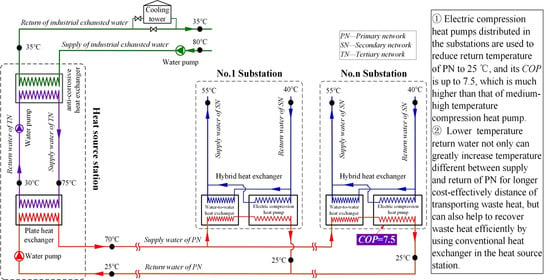New Low-Temperature Central Heating System Integrated with Industrial Exhausted Heat Using Distributed Electric Compression Heat Pumps for Higher Energy Efficiency
Abstract
1. Introduction
2. System Description
2.1. Operating Principle of CH-DHP
2.2. Operating Principle of CH-CHP
2.3. Operating Principle of CH-WHE
3. Thermodynamic Model
3.1. Main Equipment
- (1)
- Electric compression heat pump
- (2)
- Hybrid heat exchanger unit
- (3)
- Water-to-water heat exchanger
- (4)
- Circulating water pump
- (5)
- Natural gas fired boiler
3.2. Exergy Calculation
3.3. Central Heating System
3.4. Evaluation Indicators
4. Case Study
4.1. Description of the Case
- (1)
- For the given steel plant, the mass flow rate and supply temperature of exhausted water are 265.54 kg/s and 80 °C, and the requirement of the return temperature of waste water is 35 °C.
- (2)
- (3)
- Outdoor/indoor design temperatures are −21.1 °C/20 °C for space heating, and the annual heating period is 169 days.
- (4)
- Supply and return water temperatures of the secondary network are 55 °C and 40 °C, respectively.
- (5)
- Mass flow rates of the primary, secondary, and tertiary networks are constant during a heating period.
- (6)
- (7)
- Benchmark state parameters are 5 °C and 101.325 kPa for calculating exergy efficiency.
- (8)
- Interest rate is 4.8% for calculating economic benefit.
- (9)
- Annual heating price is 30 ¥/m2, and the prices of waste heat, electricity, and natural gas are 15 ¥/GJ, 0.7795 ¥/kWh, and 2.36 ¥/Nm3 (1 € = 7.8063 ¥ and 1 $ = 6.5848 ¥), respectively.
4.2. Thermodynamic Performance
4.3. Economic Benefit
5. Conclusions
- (1)
- In comparison to the other two central heating schemes, the proposed low-temperature central heating system integrated with industrial exhausted heat using distributed electric compression heat pumps has higher thermal performance and better economic benefit, and its system configuration is optimal.
- (2)
- Compared with the low-temperature central heating system integrated with industrial exhausted heat using centralized electric compression heat pumps, the proposed one using distributed electric compression heat pumps could improve the ACOP by about 5.12, and APEE by 14.9% when the exhausted heat transportation distance is 25 km.
- (3)
- The roles played by the distributed electric compression heat pumps in improving the thermal performance and economic effect of the low-temperature central heating system integrated with industrial exhausted heat are greater than those by the centralized electric compression heat pumps.
- (4)
- When the exhausted heat transportation distance is 25 km, the proposed low-temperature central heating system integrated with the industrial exhausted heat using distributed electric compression heat pumps can reduce the heating cost by about 4.40 ¥/GJ, and decrease the payback period by about 2.4 years in comparison to that using centralized electric compression heat pumps.
- (5)
- The proposed low-temperature central heating system integrated with industrial exhausted heat using distributed electric compression heat pumps has a longer economical distance of transmitting exhausted heat, which is about 25.1 km, and it would be a better choice for recovering industrial exhausted heat in Northern China.
Author Contributions
Funding
Conflicts of Interest
Abbreviations
| CH-DHP | central heating system integrated with industrial exhausted heat using distributed electric compression heat pumps |
| CH-CHP | central heating system integrated with industrial exhausted heat using centralized electric compression heat pumps |
| CH-WHE | conventional central heating system integrated with industrial exhausted heat using heat exchanger |
| PN | primary network |
| SN | secondary network |
| Q | heating capacity, W |
| m | mass flow rate, kg/s |
| h | specific enthalpy, J/kg |
| W | power, W |
| COP | coefficient of performance, W/W |
| T/t | temperature, K/°C |
| j,n | number |
| η | efficiency, % |
| △H | pressure head, mH2O |
| g | gravitational acceleration, m/s2 |
| ζ | resistance coefficient |
| ρ | density, kg/m3 |
| B | natural gas consumption, kg/s |
| e | specific exergy, J/kg |
| s | entropy, J/K |
| y | element |
| Ex | exergy flux, J |
| I | anergy flux, J |
| Ω | total heat output, J |
| τ | time, s |
| Φ | annual electricity consumption, J |
| ACOP | annual coefficient of performance |
| APEE | annual product exergy efficiency |
| AC | amortization cost, ¥ |
| IC | investment cost, ¥ |
| i | annual interest rate, % |
| PP | payback period, year |
| AP | annual profit, ¥ |
| Sub- and Super-Scripts | |
| chp | compression heat pump |
| con | condenser |
| ot | outdoor air temperature |
| hw | hot water |
| out | outlet |
| in | inlet |
| r | refrigerant |
| eva | evaporator |
| cw | cold water |
| com | compressor |
| me | mechanical efficiency |
| hhe | hybrid heat exchanger |
| whe | water-water heat exchanger |
| wp | water pump |
| cf | coefficient of friction resistance |
| cl | coefficient of local resistance |
| gfb | gas fired boiler |
| lhv | lower heating value |
| 0 | referred state point |
| ch | chemical exergy |
| co | studied object |
| w | work |
| lo | loss |
| op | output |
| ip | input |
| eng | electricity converted using natural gas |
References
- Building Energy Research Center of Tsinghua University. Annual Report of China Building Energy Conservation 2019; China’s Architecture and Building Press: Beijing, China, 2019. (In Chinese) [Google Scholar]
- National Bureau of Statistics of China. 2018. Available online: http://data.stats.gov.cn/easyquery.htm?cn=C01 (accessed on 1 February 2019). (In Chinese)
- Xiandong, T.; Xinyang, H.; Yi, F.; Lijie, G.; Baoguo, S. Review of 2014 China’s Power Supply and Demand, and 2015 Forecast. Electric Power 2015, 48, 1–5. (In Chinese) [Google Scholar]
- Lin, J.; Kahrl, F.; Liu, X. A regional analysis of excess capacity in China’s power systems. Resour. Conserv. Recy. 2018, 129, 93–101. [Google Scholar] [CrossRef]
- Togawa, T.; Fujita, T.; Dong, L.; Fujii, M.; Ooba, M. Feasibility assessment of the use of power plant-sourced waste heat for plant factory heating considering spatial configuration. J. Clean. Prod. 2014, 81, 60–69. [Google Scholar] [CrossRef]
- Ma, H.; Du, N.; Zhang, Z.; Lyu, F.; Deng, N.; Li, C.; Yu, S. Assessment of the optimum operation conditions on a heat pipe heat exchanger for waste heat recovery in steel industry. Renew. Sustain. Energy Rev. 2017, 79, 50–60. [Google Scholar] [CrossRef]
- Zhang, J.; Zhang, H.H.; He, Y.L.; Tao, W.Q. A comprehensive review on advances and applications of industrial heat pumps based on the practices in China. Appl. Energy 2016, 178, 800–825. [Google Scholar] [CrossRef]
- Wang, M.; Deng, C.; Wang, Y.; Feng, X. Exergoeconomic performance comparison, selection and integration of industrial heat pumps for low grade waste heat recovery. Energy Convers. Manag. 2020, 207, 112532. [Google Scholar] [CrossRef]
- Karner, K.; McKenna, R.; Klobasa, M.; Kienberger, T. Industrial excess heat recovery in industry-city networks: A technical, environmental and economic assessment of heat flexibility. J. Clean. Prod. 2018, 193, 771–783. [Google Scholar] [CrossRef]
- Xu, Z.Y.; Wang, R.Z.; Yang, C. Perspectives for low-temperature waste heat recovery. Energy 2019, 17, 1037–1043. [Google Scholar] [CrossRef]
- Sun, F.; Zhao, J.; Fu, L.; Sun, J.; Zhang, S. New district heating system based on natural gas-fired boilers with absorption heat exchangers. Energy 2017, 138, 405–418. [Google Scholar] [CrossRef]
- Fang, H.; Xia, J.; Jiang, Y. Key issues and solutions in a district heating system using low-grade industrial waste heat. Energy 2015, 86, 589–602. [Google Scholar] [CrossRef]
- Li, Y.; Xia, J.; Fang, H.; Su, Y.; Jiang, Y. Case study on industrial surplus heat of steel plants for district heating in Northern China. Energy 2016, 102, 397–405. [Google Scholar] [CrossRef]
- Oluleye, G.; Smith, R.; Jobson, M. Modeling and screening heat pump options for the exploitation of low grade waste heat in process sites. Appl. Energy 2016, 169, 267–286. [Google Scholar] [CrossRef]
- Lund, R.; Ilic, D.D.; Trygg, L. Socioeconomic potential for introducing large-scale heat pumps in district heating in Denmark. J. Clean. Prod. 2016, 139, 219–229. [Google Scholar] [CrossRef]
- Yang, X.; Svendsen, S. Ultra-low temperature district heating system with central heat pump and local boosters for low-heat-density area: Analyses on a real case in Denmark. Energy 2018, 159, 243–251. [Google Scholar] [CrossRef]
- Kosmadakis, G. Estimating the potential of industrial (high-temperature) heat pumps for exploiting waste heat in EU industries. Appl. Therm. Eng. 2019, 156, 287–298. [Google Scholar] [CrossRef]
- Averfalk, H.; Ingvarsson, P.; Persson, U.; Gong, M.; Werner, S. Large heat pumps in Swedish district heating systems. Renew. Sustain. Energy Rev. 2017, 79, 1275–1284. [Google Scholar] [CrossRef]
- Yang, Y.; Wu, K.; Long, H.; Gao, J.; Yan, X.; Kato, T.; Suzuoki, Y. Integrated electricity and heating demand-side management for wind power integration in China. Energy 2014, 78, 235–246. [Google Scholar] [CrossRef]
- Hu, B.; Liu, H.; Wang, R.Z.; Li, H.; Zhang, Z.; Wang, S. A high-efficient centrifugal heat pump with waste heat recovery recovery for district heating. Appl. Therm. Eng. 2017, 125, 359–365. [Google Scholar] [CrossRef]
- Kwon, O.; Cha, D.; Park, C. Performance evaluation of a two-stage compression heat pump system for district heating using waste energy. Energy 2013, 57, 375–381. [Google Scholar] [CrossRef]
- Cao, X.Q.; Yang, W.W.; Zhou, F.; He, Y.L. Performance analysis of different high-temperature heat pump systems for low-grade waste heat recovery. Appl. Therm. Eng. 2014, 71, 291–300. [Google Scholar] [CrossRef]
- Hu, B.; Xu, S.; Wang, R.Z.; Liu, H.; Han, L.; Zhang, Z.; Li, H. Investigation on advanced heat pump systems with improved energy efficiency. Energy Convers. Manag. 2019, 192, 161–170. [Google Scholar] [CrossRef]
- Bamigbetan, O.; Eikevik, T.M.; Nekså, P.; Bantle, M.; Schlemminger, C. The development of a hydrocarbon high temperature heat pump for waste heat recovery. Energy 2019, 173, 1141–1153. [Google Scholar] [CrossRef]
- Fangtian, S.; Haoyuan, Y.; Lin, F.; Junwei, G. Operation characteristics and application of low temperature industrial waste heating system based on compression heat exchanger. Acta Energy Sol. Sin. 2018, 39, 1495–1501. (In Chinese) [Google Scholar]
- Sun, J.; Fu, L.; Zhang, S. Experimental study of heat exchanger basing on absorption cycle for CHP system. Appl. Therm. Eng. 2016, 102, 1280–1286. [Google Scholar] [CrossRef]
- Sun, F.; Chen, X.; Fu, L.; Zhang, S. Configuration Optimization of an Enhanced Ejector Heat Exchanger Based on an Ejector Refrigerator and a Plate Heat Exchanger. Energy 2018, 164, 408–417. [Google Scholar] [CrossRef]
- Liu, J.; Li, Q.; Wang, F.; Zhou, L. A new model of screw compressor for refrigeration system simulation. Int. J. Refrig. 2012, 35, 861–870. [Google Scholar] [CrossRef]
- Yu, F.W.; Chan, K.T. Improved energy performance of air cooled centrifugal chillers with variable chilled water flow. Energy Convers. Manag. 2008, 49, 1595–1611. [Google Scholar] [CrossRef]
- Browne, M.W.; Bansal, P.K. An elemental NTU-ε model for vapour-compression liquid chillers. Int. J. Refrig. 2001, 24, 612–627. [Google Scholar] [CrossRef]
- Cengel, Y.A.; Boles, M.A. Thermodynamics: An Engineering Approach, 8th ed.; McGraw-Hill Eduation Publisher: Boston, MA, USA, 2015. [Google Scholar]
- Weicheng, W.; Runtian, M. Energy Efficient Utilization of Technology; Chemical Industry Press: Beijing, China, 1984. (In Chinese) [Google Scholar]
- Xiaoqing, L. Practical Heating and Air Conditioning Design Manual, 2nd ed.; China’s Architecture and Building Press: Beijing, China, 2008. (In Chinese) [Google Scholar]
- Ministry of Housing and Urban-Rural Development of the People’s Republic of China (MOHURD). Industry standard of the People’s Republic of China: Design code for city heating network (CJJ 34-2010); China’s Architecture and Building Press: Beijing, China, 2010. (In Chinese) [Google Scholar]
- Ahamed, J.U.; Saidur, R.; Masjuki, H.H. A review on exergy analysis of vapor compression refrigeration system. Renew. Sustain. Energy Rev. 2011, 15, 1593–1600. [Google Scholar] [CrossRef]
- Tian, Y.; Yuan, H.; Wang, C.; Wu, H.; Xing, Z. Numerical investigation on mass and heat transfer in an ammonia oil-free twin-screw compressor with liquid injection. Int. J. Therm. Sci. 2017, 120, 175–184. [Google Scholar] [CrossRef]
- Standard Fixed Institute of MOHURD. Indicators of Investment in Public Works Estimates; China’s Planning Press: Beijing, China, 2007. (In Chinese) [Google Scholar]

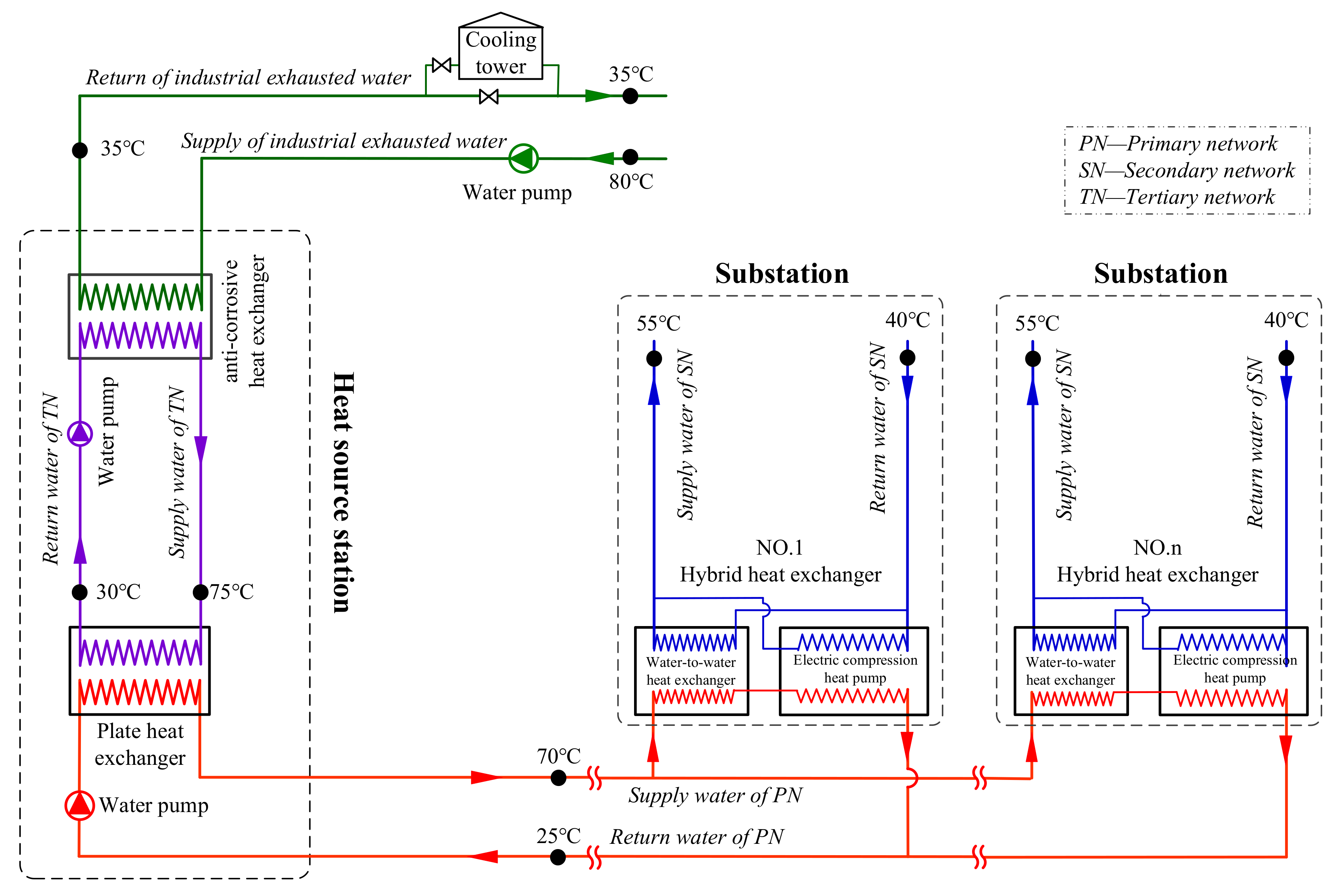

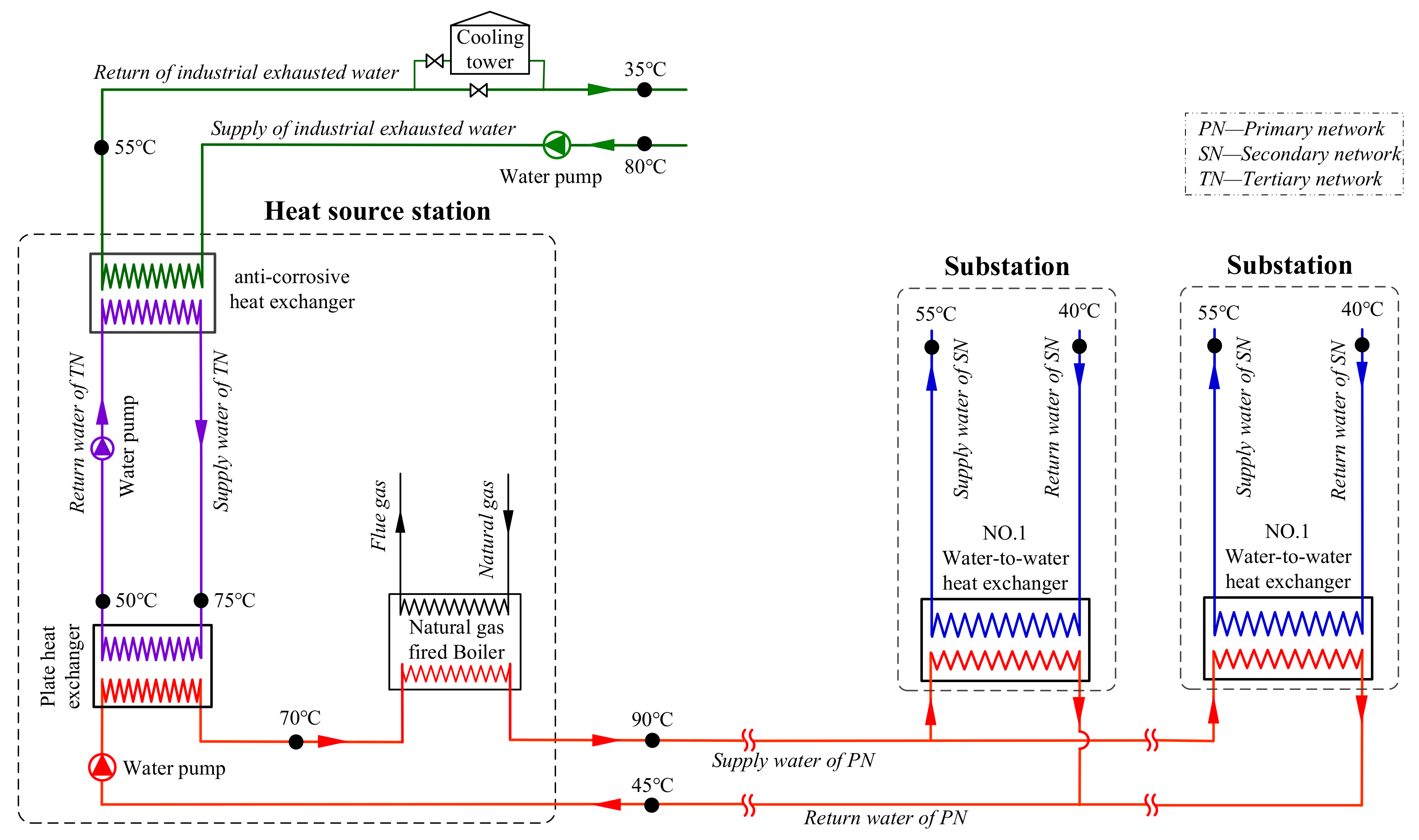
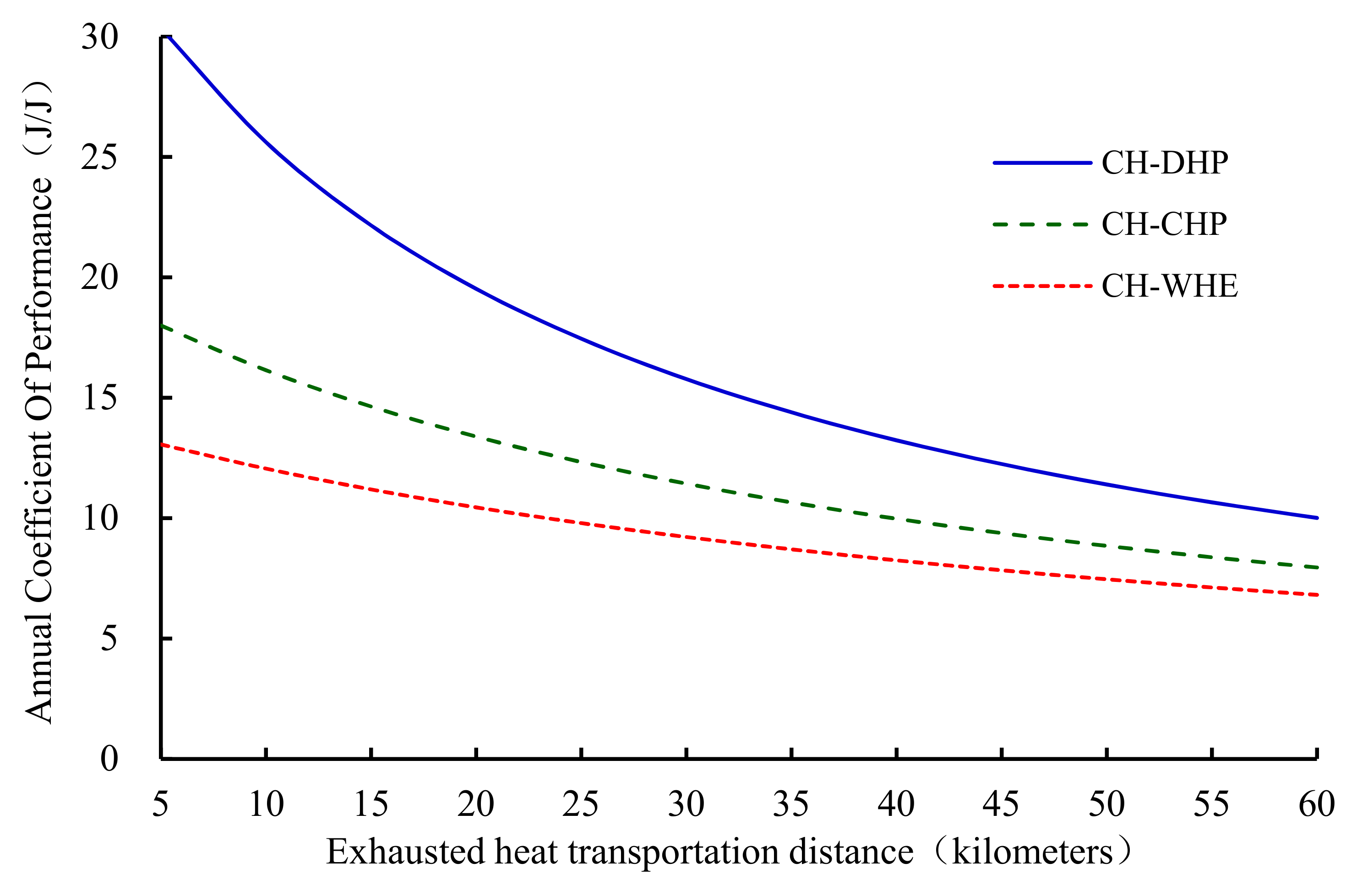




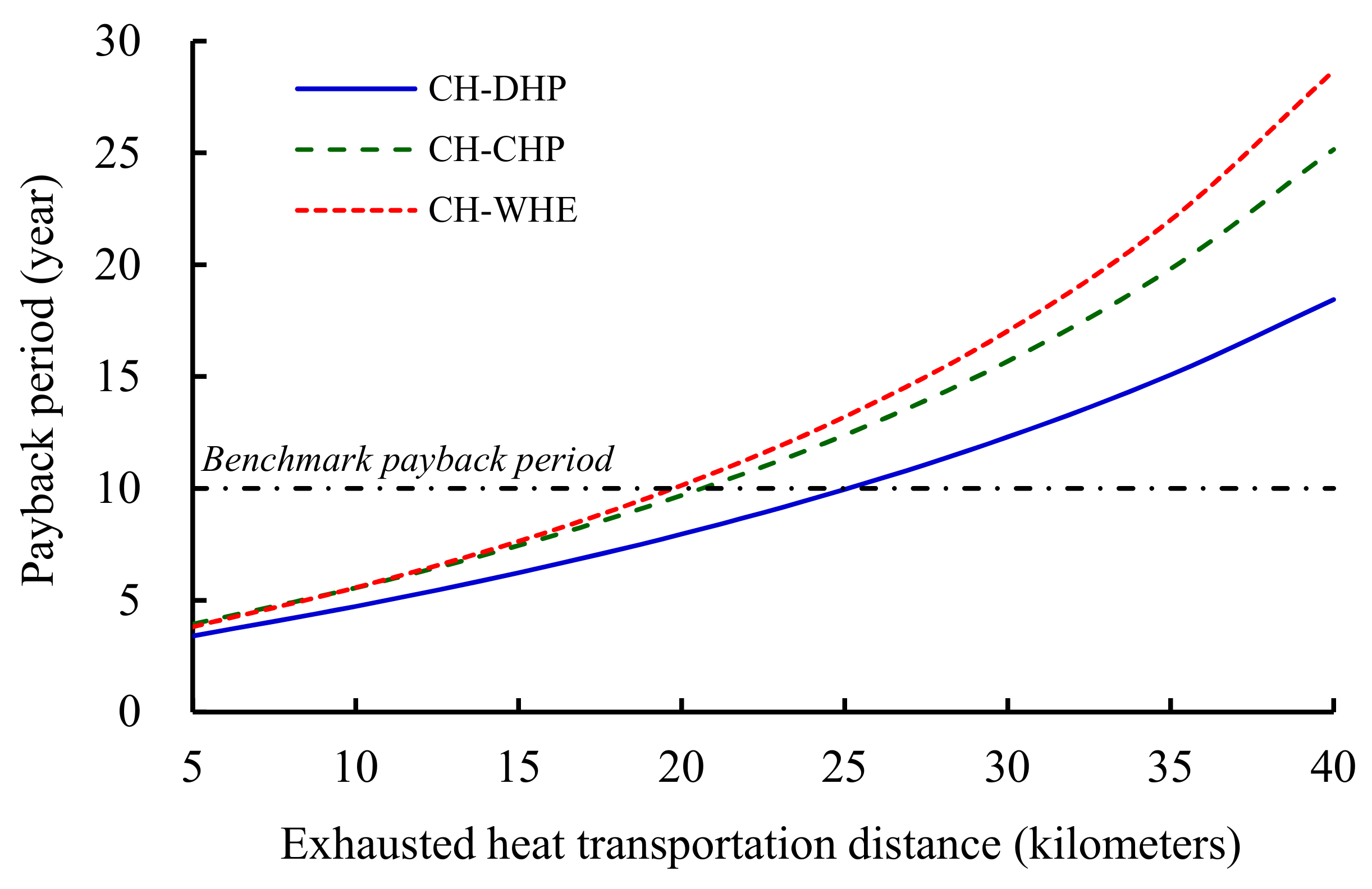
| Subsystem | Equipment | Items | CH-DHP | CH-CHP | CH-WHE |
|---|---|---|---|---|---|
| Heating station | Slag slushing water | Mass flow rate (kg/s) | 265.54 | 265.54 | 265.54 |
| Anticorrosive plate heat exchanger | Heating capacity (W) | 47,625,500 | 37,474,300 | 27,746,420 | |
| Plate heat exchanger | Heating capacity (W) | 47,625,500 | 27,746,420 | 27,746,420 | |
| Compression heat pump | Heating capacity (W) | —— | 11,873,340 | —— | |
| COP (W/W) | —— | 4.50 | —— | ||
| Natural gas-fired boiler | Heating capacity (W) | —— | 10,380,250 | 22,253,580 | |
| Primary heating network | Circulating water | Mass flow rate (kg/s) | 253.20 | 265.54 | 265.54 |
| Heating substation | Compression heat pumps | Heating capacity (W) | 21,428,000 | —— | —— |
| COP (W/W) | 7.50 | —— | —— | ||
| Water-to-water heat exchangers | Heating capacity (W) | 28,572,000 | 50,000,000 | 50,000,000 | |
| Secondary heating network | Circulating water | Mass flow rate (kg/s) | 796.49 | 796.49 | 796.49 |
| Subsystem | Item | CH-DHP | CH-CHP | CH-WHE |
|---|---|---|---|---|
| Heating station | Equipment cost (¥) | 9,679,140 | 17,179,150 | 13,679,160 |
| Construction cost (¥) | 1,451,870 | 2,576,880 | 2,051,880 | |
| Installment cost (¥) | 1,935,830 | 3,435,830 | 2,735,830 | |
| Other cost (¥) | 3,037,440 | 4,183,370 | 3,658,370 | |
| Primary heating network (15 km) | Pipe and equipment cost (¥) | 14,630,100 | 15,428,720 | 15,411,370 |
| Construction cost (¥) | 20,830,960 | 21,075,590 | 21,075,590 | |
| Installment cost (¥) | 7,092,210 | 7,300,860 | 7,297,390 | |
| Other cost (¥) | 3,546,110 | 3,650,430 | 3,648,700 | |
| Heating substation | Equipment cost (¥) | 12,379,910 | 5,000,000 | 5,000,000 |
| Construction cost (¥) | 1,856,990 | 750,000 | 750,000 | |
| Installment cost (¥) | 2,475,980 | 1,000,000 | 1,000,000 | |
| Other cost (¥) | 1,856,990 | 750,000 | 750,000 | |
| Total capital investment | 80,773,530 | 82,330,830 | 77,058,290 | |
Publisher’s Note: MDPI stays neutral with regard to jurisdictional claims in published maps and institutional affiliations. |
© 2020 by the authors. Licensee MDPI, Basel, Switzerland. This article is an open access article distributed under the terms and conditions of the Creative Commons Attribution (CC BY) license (http://creativecommons.org/licenses/by/4.0/).
Share and Cite
Sun, F.; Xie, Y.; Svendsen, S.; Fu, L. New Low-Temperature Central Heating System Integrated with Industrial Exhausted Heat Using Distributed Electric Compression Heat Pumps for Higher Energy Efficiency. Energies 2020, 13, 6582. https://doi.org/10.3390/en13246582
Sun F, Xie Y, Svendsen S, Fu L. New Low-Temperature Central Heating System Integrated with Industrial Exhausted Heat Using Distributed Electric Compression Heat Pumps for Higher Energy Efficiency. Energies. 2020; 13(24):6582. https://doi.org/10.3390/en13246582
Chicago/Turabian StyleSun, Fangtian, Yonghua Xie, Svend Svendsen, and Lin Fu. 2020. "New Low-Temperature Central Heating System Integrated with Industrial Exhausted Heat Using Distributed Electric Compression Heat Pumps for Higher Energy Efficiency" Energies 13, no. 24: 6582. https://doi.org/10.3390/en13246582
APA StyleSun, F., Xie, Y., Svendsen, S., & Fu, L. (2020). New Low-Temperature Central Heating System Integrated with Industrial Exhausted Heat Using Distributed Electric Compression Heat Pumps for Higher Energy Efficiency. Energies, 13(24), 6582. https://doi.org/10.3390/en13246582





